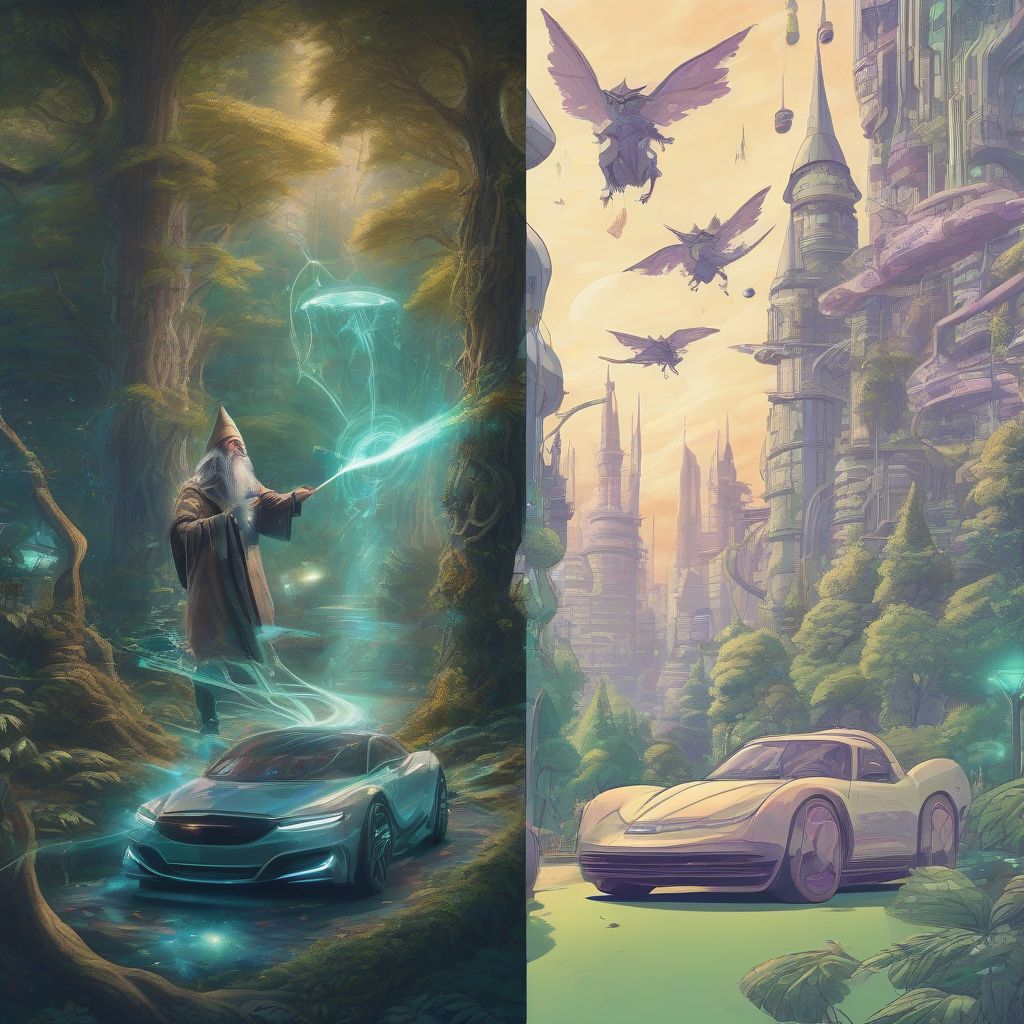Imagine a world where spaceships soar through galaxies, but magic also flickers in the shadows. This intriguing blend, where advanced technology dances with mythical creatures and ancient spells, is where the realms of science fiction and fantasy intertwine. While often perceived as distinct genres, delving deeper reveals a fascinating and complex relationship. So, how do we begin to explore this captivating intersection?
Shared DNA: The Common Ground of Speculative Fiction
Both science fiction and fantasy reside under the expansive umbrella of “speculative fiction.” This shared category signifies a focus on worlds and narratives that diverge from our reality. Both genres explore “what if” scenarios, sparking our imagination and challenging our perceptions of the possible.
Imagination as the Engine: Fueling Both Genres
The very heart of both science fiction and fantasy lies in the boundless realm of imagination. Authors in both genres construct worlds governed by unique rules and populated by fantastical beings. This shared foundation of boundless creativity forms the bedrock of their relationship.
Escapism and Social Commentary: Mirroring Reality Through Different Lenses
Both genres offer readers an escape from the mundane, transporting them to extraordinary realms. Yet, beneath the surface of fantastical narratives often lie incisive social commentaries. Science fiction might explore the ethical implications of advanced technology, while fantasy might use allegorical tales to examine societal structures and power dynamics.
Distinguishing Features: Where the Paths Diverge
While sharing a common ancestor in speculative fiction, science fiction and fantasy diverge in their approaches to world-building and thematic concerns.
The Logic of Science vs. the Allure of Magic
Science fiction grounds itself in scientific principles, even when exploring futuristic technologies that push the boundaries of our current understanding. It thrives on plausibility, often extrapolating from existing scientific knowledge to envision potential futures.
Fantasy, on the other hand, embraces the supernatural, the magical, and the mythical. It revels in the impossible, inviting readers to suspend disbelief and embrace the enchantment of otherworldly powers.
Internal vs. External Conflicts: Exploring the Human Condition
While both genres delve into the complexities of the human condition, science fiction often emphasizes external conflicts. Think battles against alien races, the struggle for survival in dystopian societies, or the ethical dilemmas posed by artificial intelligence.
Fantasy, conversely, frequently delves into internal conflicts, exploring themes of self-discovery, morality, and the battle against inner demons. These conflicts often manifest in epic quests, magical trials, and confrontations with mythical creatures.
 Fantasy vs. Science Fiction
Fantasy vs. Science Fiction
Bridging the Divide: Where Science Fiction and Fantasy Converge
Despite their differences, the lines between science fiction and fantasy are becoming increasingly blurred, leading to captivating hybrid genres.
Science Fantasy: The Fusion of Wonder and Technology
Science fantasy represents the exciting convergence of these two genres. Here, spaceships might traverse galaxies powered by mystical crystals, or advanced civilizations might coexist with mythical creatures. This subgenre embraces the strengths of both, creating worlds rich in both technological marvels and magical wonders.
Examples of Genre-Bending Masterpieces
Literature is replete with examples of works that seamlessly blend science fiction and fantasy. Ursula K. Le Guin’s “Earthsea” series, for instance, combines elements of magic, dragons, and coming-of-age narratives within a world that also grapples with the ethical implications of wielding immense power. Similarly, Frank Herbert’s “Dune” universe presents a futuristic interstellar society deeply intertwined with mysticism, prophetic visions, and ecological complexities.
Exploring the Intersection: A Journey of Discovery
For readers and writers alike, exploring the relationship between science fiction and fantasy unlocks a universe of creative possibilities. Here are some tips to embark on this exciting journey:
- Read Widely: Venture beyond your comfort zone. Explore classic and contemporary works from both genres to understand their nuances and appreciate the diversity within each category.
- Analyze and Compare: As you read, pay attention to how authors construct their worlds, develop their characters, and address thematic concerns. Compare and contrast how science fiction and fantasy approach similar themes.
- Embrace the Blur: Don’t be afraid to explore works that defy easy categorization. Science fantasy, with its unique blend of elements, offers a particularly fertile ground for discovering innovative storytelling and thought-provoking concepts.
- Unleash Your Creativity: Whether you’re a writer or a reader, allow the interplay between science fiction and fantasy to spark your imagination. Explore the “what ifs,” challenge conventions, and embrace the boundless possibilities of speculative fiction.
Conclusion: A Tapestry of Infinite Possibilities
The relationship between science fiction and fantasy is a dynamic and ever-evolving one. These genres, while distinct in their approaches, share a common ancestry in speculative fiction and a commitment to pushing the boundaries of imagination. By exploring their shared territories, appreciating their differences, and embracing the exciting possibilities of their convergence, we open ourselves to a universe of storytelling that is both thought-provoking and endlessly entertaining.
So, dive into the pages of a science fiction epic or get lost in a world of fantasy and magic. You might be surprised by the connections you discover and the new worlds that open to you. After all, the most extraordinary journeys often begin at the intersection of the known and the unknown, where the impossible becomes possible, and the only limit is the power of imagination.
[amazon bestseller=”science fantasy books”]
